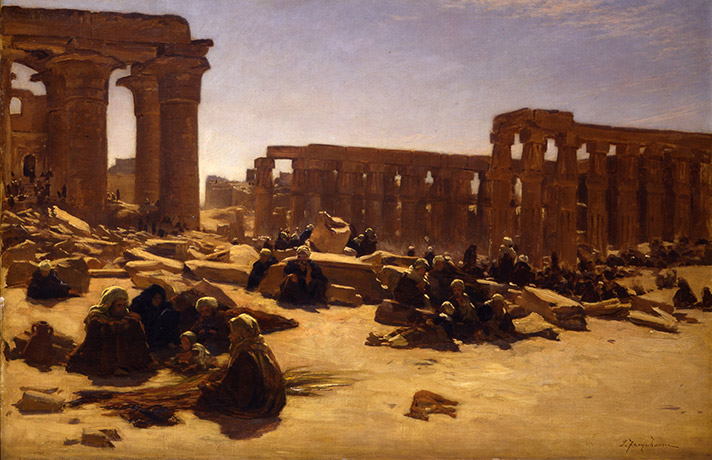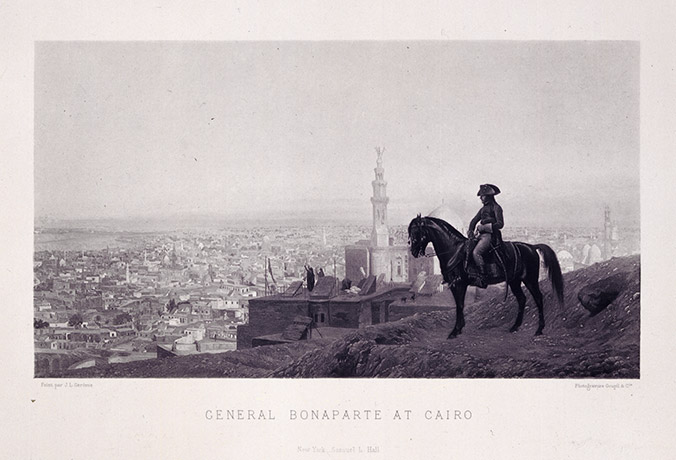Napoleon on the Nile: Soldiers, Artists, and the Rediscovery of Egypt
August 30, 2008 - January 04, 2009
This exhibition vividly tells the story of Napoleon’s ill-fated bid to add Egypt to the growing French empire and of how the British, who had their own colonial interests in the region to protect, ultimately thwarted this plan. As a military and colonial endeavor, the Egyptian campaign (1798–1801) was a failure, yet it paradoxically ranks among Napoleon’s most significant achievements.
In addition to his soldiers, Napoleon also brought to Egypt 150 scholars, or savants, whose project it was to systematically explore, describe, and document every aspect of the country: its ancient and modern buildings and monuments; its plants, animals, and people; its topography; and its commerce, customs, and infrastructures. Egypt was soon to become the most thoroughly mapped region on earth.
Supported by Napoleon and protected (sometimes begrudgingly) by the army, this select group of engineers, scientists, mathematicians, naturalists, and artists—called the Commission des Sciences et des Arts d’Égypte—was an integral part of the expedition. They served France’s political mission by providing the comprehensive information and skills an occupying force would need to govern and rebuild effectively. At the same time they enhanced the expedition’s ideological goals by rediscovering the wonders of Pharaonic Egyptian civilization, with which Napoleon, in his dual roles of liberator and conqueror, was happy to be associated.
The ultimate product of the Commission’s exhaustive research was the Description de l’Égypte, a massive, encyclopedic compendium published between 1809 and 1828. An unprecedented scholarly achievement, its first edition was composed of ten volumes of text and thirteen volumes of engraved plates. It is considered the foundational work of modern Egyptology.
Bringing together more than eighty plates from the Description de l’Égypte, vivid nineteenth-century Orientalist paintings that were influenced by those illustrations, and a selection of campaign letters and documents, this exhibition explores the legacy of the brief French occupation of Egypt and reveals how the interaction between military power, scientific knowledge, and artistic skills shaped the West’s enduring image of the country.
—Lisa Small, Independent Curator
Napoleon on the Nile offers a rare opportunity to look closely at the strategies for constructing and representing “other” cultures—important mechanisms of any colonial enterprise, historical or contemporary. Post-colonial theorists such as Edward Said, Homi Bhaba, and Gayatri Spivak write about how the separation of “Us” from “Them” has long been inscribed into master discourses such as Anthropology, History, and Art History. “They” occupy a time and space “out there,” which “we” must re-create, stage, or represent for an audience “in here.” Filmmaker and theorist Trinh Minh-ha describes this separation in predatory terms: “I” as sovereign territory advancing on the “other” out there in the sphere of acquisition. She extends this metaphor of stalking, seizure, and mastery to dominant modes of representation in (ethnographic) film, calling them modes of “all-owning spectatorship.”
Although Napoleon and his savants would never have used the term, “all-owning spectatorship” is a concept central to their ambitious print project Description de l’Égypte. Each of the Description’s volumes, variously devoted to Ancient Egypt, the Modern State, and Natural History, served France’s colonial aim of mapping all of Egypt’s resources and of making the Near East useful to the French Empire.
—Robin Held, Frye Chief Curator and Director of Exhibitions and Collections
Related Exhibition
Oasis: Western Dreams of the Ottoman Empire from the Dahesh Museum of Art
Tacoma Art Museum
September 20, 2008–January 4, 2009
In tandem with Napoleon on the Nile at the Frye, this exhibition at Tacoma Art Museum presents a broad, international survey of Western artists’ responses to the cultures and landscapes of the Ottoman Empire and the art movement that arose from the Western fascination with the East, which peaked in the nineteenth century following Napoleon’s military campaign in Egypt (1798–1801). Oasis offers important historical and cultural perspectives on the challenging questions of the “Orient” and its representation in art. Organized by the Dahesh Museum in New York, the exhibition includes approximately sixty paintings, sculptures, photographs, prints, and drawings.
Napoleon on the Nile is organized by the Dahesh Museum of Art, New York. The exhibition is coordinated for the Frye by Robin Held, chief curator and director of exhibitions and collections.
Edwin Longsden Long. Love’s Labour Lost, 1885. Oil on canvas. 67 1/2 x 92 in. © Dahesh Museum of Art, 1995.10.
Joseph Farquharson. The Ruins of the Temple at Luxor, ca. 1890. Oil on canvas, 37 ¼ x 49 3/8. © Dahesh Museum of Art, 1995.7.
After Jean-Léon Gérôme. General Napoleon at Cairo from Gérome, A Collection of the Works of J. L. Gérome in One Hundred Photogravures, 1881. Photogravure. © Dahesh Museum of Art, 1997.55e.


